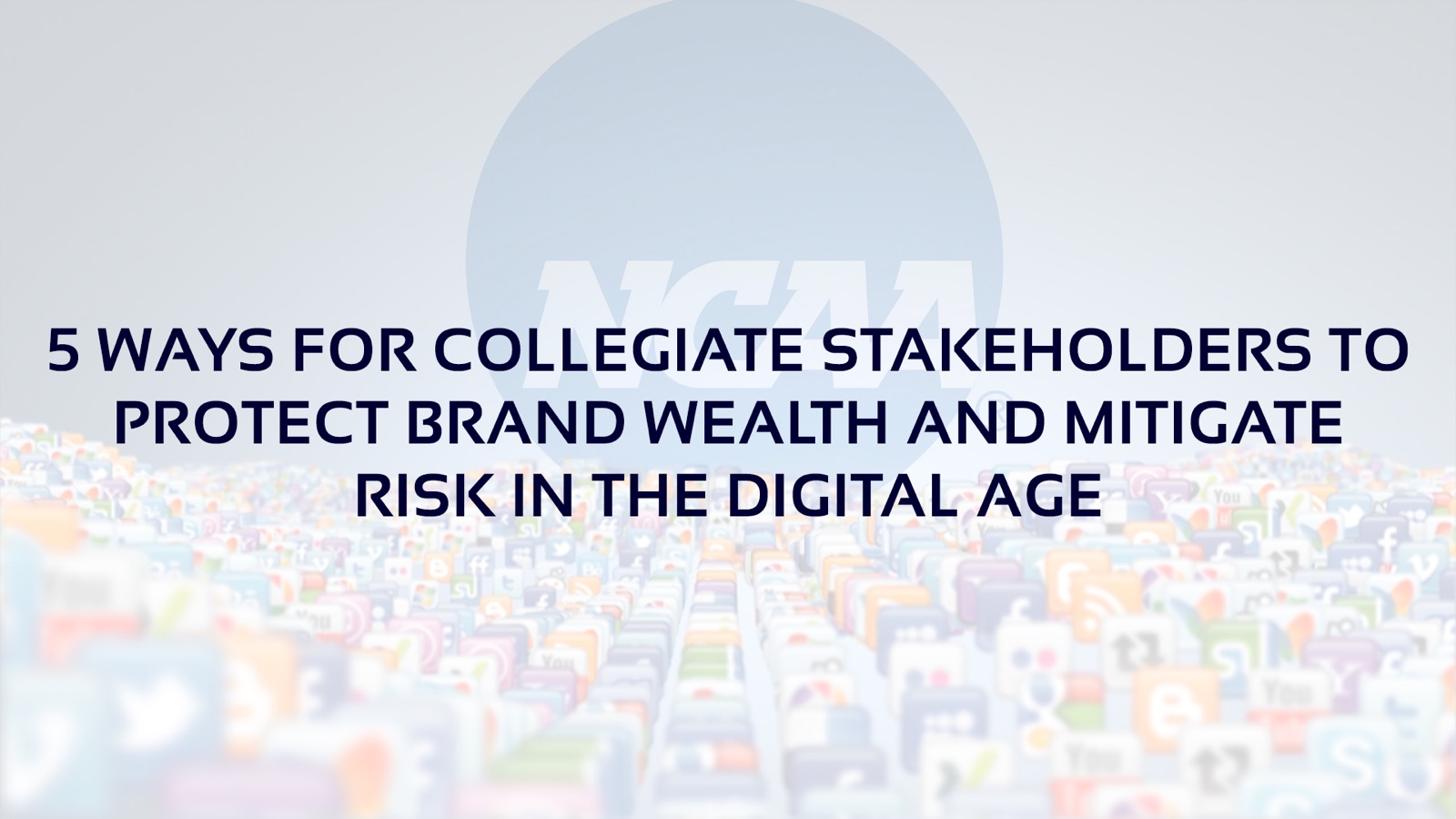Let’s be honest, no matter how successful athletic programs are in the NCAA, there is the likelihood that something will go wrong and a stakeholder will be pushed to a virtual podium to face a barrage of online and in-person inquires. With the instantaneous accessibility of information on social media and real-time (and fake) news to influence the court of public opinion, there has never been a more critical time in history for stakeholders to reevaluate risk management strategies in order to protect brand wealth and safeguard their reputations.
Here are 5 brand wealth and risk management strategies for you to deliberate as you jump the crisis curve in the digital age.
1. Understand Your Risks
Understanding your risks means thinking and rethinking vulnerabilities, audience and inside-out deployment lines. It is vital for relevant c-suite risk management strategies to incorporate digital brand wealth discovery phases into their risk management plans. Social listening tools will help excavate the labyrinth of known and unknown internal and external potential perils in order to create more robust risk management plans. Digital technology now enables stakeholders to gather a litany of information to better understand the potential pitfalls and what narratives to produce, when to deploy them, and how to pivot for maximum positive outcomes. Analytical support is not subjective and advances meaningful messaging to protect a brand’s wealth and reputation.
2. Proactively Mitigate Your Risk
Proactively mitigating risks means addressing perceived brand threats with preemptive training, education, policies, procedures, outside experts and accountability contracts. In today’s highly investigative and litigious populaces, stakeholders can no longer simply do the right thing, but they must be able to prove they implemented the right thing. Partnering with neutral and third party professionals to create transparent and fair departmental reviews, as well as executing directives and compulsory online programming and education provides constituents necessary best practices while documenting a digital footprint of an athletic brand’s intentions and implementations to deliver the utmost welfare for student-athletes, staff, coaches, partners, faculty, donors and fans.
3. Create Tactical Risk Plans
Creating tactical risk plans means being ready for a crisis from an on-site management standpoint to disseminating your messaging to inform, protect and serve. Digital technology has changed how we distribute and receive information. Because of the immediate nature of social media, what was once a 24-to-72 hour window to create legally branded statements to notify constituency and protect the stakeholders is now 2-minutes or less. Be prepared with internal athletic communication’s procedures and war room tactical drills to: say it first, say it yourself and say it truthfully.
4. Deal Honestly With Risks
Dealing honestly with risks means understanding mistakes, accidents and tragedy will happen no matter how prepared and forthright your program is today. The ability to lead effectively in code red situations will depend on the culture of the program and its leadership. Nothing kills an effective crisis plan more quickly than a hubris leader in a reactive position who ultimately pawns the onus of responsibility onto others. Strong risk management demands stripping away the “We got this,” attitude and plugging in routine internal checks and balances to understand the evolution of upholding brand wealth. With the accessibility of digital forensics, the ability to respond with conviction and transparency will help to build public confidence and reduce negative backlash. Keep learning!
5. Grow From Risks
Growing from risk means that your brand becomes stronger internally and externally because they faced issues justly and with assurance to change a culture if needed. Utilizing digital technology listening tools to create, pivot and deliver successful brand cleanup and progression campaigns will help to increase positive sentiment faster and more effectively. From behavioral, competition or compliance issues to unforeseen tragedy, stakeholders are more liable than ever to provide relevant ways to proactively approach, successfully manage and confidently grow from brand turmoil.
Conclusion
What we have learned is that digital technology has changed the game of risk aversion, crisis management and brand wealth protection. The positive is that it has enabled stakeholders to have greater knowledge, strategies, training and tools at their fingertips before, during and after a crisis to protect themselves. The downside is that it exposes an executive and their brand’s weaknesses more quickly and widely than ever before. Thus, pioneering stakeholders in athletics are jumping the digital curve to protect brand wealth on the front end with preemptive risk discovery, digital listening tools, online training and third party procedures to preserve reputations, careers and brands in times of trouble. It is much more cost-effective and brand-incentivized to proactively prepare on the front end than to spend millions of dollars on costly crisis management firms on the back end.
About the Author
Over the past two decades Carrie Cecil has counseled countless c-suite executives to address the cutting-edge advancements of crisis communications, digital technology and social media on their brands. She is a well known speaker and author who founded Anachel Communications and is the CEO of Social Media Sports Management (SM2).











